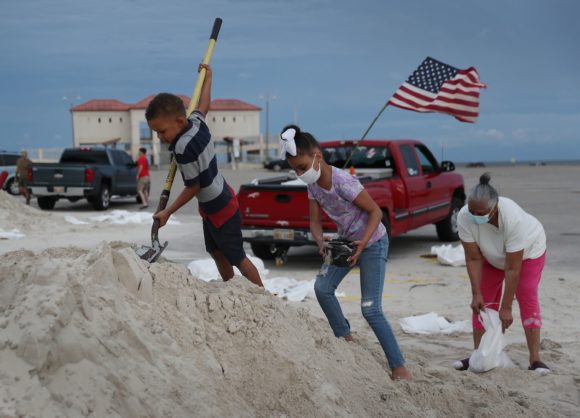Hurricane Sally has weakened as it approaches the U.S. Gulf Coast, with hurricane warnings being replaced by tropical storm alerts and a number of further storm warnings being discontinued.
The storm’s maximum sustained winds slowed to 85 miles (140 kilometers) per hour, a Category 1 on the Saffir-Simpson scale, according to a National Hurricane Center report published at 4 a.m. in New York. The storm is about 60 miles east-southeast of the mouth of the Mississippi River.
Sally, which has sparked evacuations from some offshore energy platforms, will make landfall sometime Tuesday night or Wednesday, but exactly where is difficult to say. Warnings extend from southeastern Louisiana, including New Orleans, to the Florida Panhandle. Little change in strength is forecast until landfall occurs.
The U.S. has been pummeled by natural disasters this year, with wildfires devastating the West, storms causing billions of dollars of damage in the East and along the Gulf Coast, and a derecho ripping through the Midwest earlier this summer. With the emergence of Tropical Storm Vicky, the Atlantic basin has now produced 20 storms, the second most on record. Only 2005 had more storms, with 28.
“We have everything from fires to hurricanes and everything in between,” said Jim Rouiller, lead meteorologist with the Energy Weather Group. He said the most destructive part of the storm may miss New Orleans.
A larger weather system over the U.S. is making an exact track difficult to forecast, but Sally could be the second hurricane since late August to hit Louisiana, which is still recovering from Hurricane Laura.
Louisiana Governor John Bel Edwards declared an emergency, and New Orleans Mayor LaToya Cantrell issued a similar warning for the city. The storm could raise ocean levels 7 to 11 feet (2 to 3 meters) at the mouth of the Mississippi River, which could overtop some levees.
The storm could potentially lead to between $2 billion to $3 billion in damage and losses, said Chuck Watson, a disaster modeler with Enki Research. Damage estimates have fluctuated because Sally’s forecast intensity and track have shifted several times in the last few days. The price tag could rise even more if Sally gets stronger or takes more time moving through the area, or if water overwhelms flood control systems in New Orleans.
Oil Disruption
Sally will sweep the eastern edge of the offshore production area, halting some oil and natural gas drilling for a short time and adding further disruption to the industry. Hurricanes Marco and Laura, as well as Tropical Storm Cristobal, all disrupted work across the Gulf this season.
Across the Gulf, nearly 23% of production platforms and 30% of rigs have been evacuated, according to the Bureau of Safety and Environmental Enforcement. Just over 21% of oil production and more than 25% of gas has been shut in.
Mississippi River bar pilots also halted operations Sunday. Phillips 66 has begun a shutdown of the Alliance refinery, the company said in a statement.
Along with its storm surge, which can vary due to tides and exactly where the storm makes landfall, Sally could bring 2 to 3 feet of rain in some places, causing massive flooding, Rouiller said. If Sally continues to slow, the potential impact could be worse, and refineries may be down for longer.
“I am worried it is going to slow up and intensify,” Rouiller said. “Sally may become known for the severe flooding.”
The floods could impact cotton, corn and peanut crops through the region, though widespread damage isn’t expected, said Don Keeney, a meteorologist with commercial forecaster Maxar.
“I don’t think we are going to see any massive damage, but there will be some localized flood damage right along the path,” Keeney said. “I don’t think it will have much of an impact on the Delta.”
Seven storms have hit the U.S. in 2020, including Laura, which devastated southwest Louisiana, and Hurricane Isaias, which temporarily knocked out power to millions in the Northeast.
In addition to Sally, Hurricane Paulette is battering Bermuda. The other storms — Rene, Teddy and Vicky — won’t be an immediate threat to land.
–With assistance from Kevin Crowley, David Wethe, Robert Tuttle, Dan Murtaugh, Serene Cheongand Sheela Tobben.
About the photo: Christian Clark, Darrianna Bogan and Glorida Lyonn fill sandbags on September 14, 2020 in Biloxi, Mississippi. Now categorized as category 2, Hurricane Sally threatens to bring heavy rain, high winds and a dangerous storm surge from Louisiana to Florida. Photographer: Joe Raedle/Getty Images
Was this article valuable?
Here are more articles you may enjoy.


 Palantir Poaching Suit Called ‘Scare’ Tactic by Ex-Employees
Palantir Poaching Suit Called ‘Scare’ Tactic by Ex-Employees  US Lawmaker Unveils Bill Requiring Manual Car-Door Releases
US Lawmaker Unveils Bill Requiring Manual Car-Door Releases  NYC Sues Delivery App Over Lost Pay in New Mamdani Crackdown
NYC Sues Delivery App Over Lost Pay in New Mamdani Crackdown  Cyber Breach Affected 750,000 Canadian Investors, Regulator Says
Cyber Breach Affected 750,000 Canadian Investors, Regulator Says 